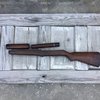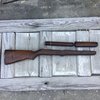I rubbed in a coat of BLO this morning, I think it’s going to turn out nice.


I will end up applying to more coats, but they will just be polish coats.
If you ask 10 people, what is the correct way to apply aBLO finish, you might get 5 to 7 difference answers. But here’s the problem, two or three of the answers may be right.
The first time I did a BLO finish was in 1988. I had an old Gunsmith as a mentor. He never cut my slack because and made sure I did things right. If I had to count how many BOL finishes I’ve done over the years, it would be in the hundreds.
For those of you that would like to know how to apply BLO, this part is for y’all. I’ll cover the why and how of the finish.
A few notes first.
#1 You are applying oil into the surface of the wood, not oil soak the wood. Each time you apply a coat, it’s really not a coat, but that is just what it’s called.
#2 Do not let BLO dry on the surface, it will get gummy. If this happens you will need to wipe the stock down with mineral spirits.
#3 A wax top coat is needed to protect the finish.
#4 Never be in a rush to finish.
Let’s get started. Your first coat (the wet coat) needs to be very wet and rubbed in. You want your hand to get warm from rubbing. Once this coat is rubbed in, you want to leave the surface wet. This first coat will let you know how Dey your stock is. Once done with the coat let the stock sit for 30 min. The stock may or may not soak up the oil from the surface. After the 30 min. Use a rag or paper towel to wipe it dry. I prefer paper towels.
Now don’t worry these rags or paper towels will not burst into flames. Just set them out where they can air dry before you put them in the trash.
You will now have to let the stock set for 24 hours. This will allow the oil in the surface of the wood cure.
For the second coat. If the first coat was soaked up leaving very little on the surface. Your stock is dry and you need to apply another wet coat. If the stock didn’t soak up that much you can start your polish coats or a rub coat. Let’s say coat two will be a rub coat. What you want is to apply just enough to keep the area you are rubbing a little wet. You will find that as you rub, your hand may get warmer then on the wet coat.
Rub the stock down very good then let it sit for 30 min. Then wipe it dry and let it sit 24 hours.
For the third coat you can do another rub coat if you feel the stock needs more oil, or start the polish coats.
A polish coat is applied sparingly and you want to rub it until your hand becomes hot. At this point you should start to see the wood grain really start to show. Once you’re done rubbing in the polish, the surface should look almost dry with no oil standing on the surface. Let the stock sit for 30 min. Then wipe it down with clean paper towels. You should get very little oil on the paper towel. Let the stock sit for 24 hours.
I like to apply two polish coats. Once you have finished your last polish coat and wiped down, let the stock sit for 48 hours. After 48 hours use a clean dry paper towel and rub the stock a little. If some oil comes off, let the stock sit another 24 hours. You want the oil in the stock to cure. If it is not, your wax top coat will turn cloudy and have to be removed.
Now it’s time to protect all that hard work. There are different types of furniture wax out there, but you want paste wax. Min Wax works great but I prefer a 3 in one wax. Tom’s 3 in 1 military stock wax is good stuff. Using your fingers rub the wax to soften it an apply to the stock. Then rub it into the stock by hand. Allow time for the wax to dry then buff it with a soft clean cloth. Two coats of wax should be enough.
Now put your rifle back together and go have some fun.
I hope that this helps.






























































